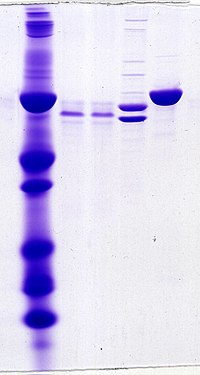
Photo from wikipedia
Background Reports on typical routine cerebrospinal fluid (CSF) findings are outdated owing to novel reference limits (RL) and revised diagnostic criteria of Multiple Sclerosis (MS). Objective To assess routine CSF… Click to show full abstract
Background Reports on typical routine cerebrospinal fluid (CSF) findings are outdated owing to novel reference limits (RL) and revised diagnostic criteria of Multiple Sclerosis (MS). Objective To assess routine CSF parameters in MS patients and the frequency of pathologic findings by applying novel RL. Methods CSF white blood cells (WBC), CSF total protein (CSF-TP), CSF/serum albumin quotient (Qalb), intrathecal synthesis of immunoglobulins (Ig) A, M and G, oligoclonal IgG bands (OCB) were determined in patients with clinically isolated syndrome (CIS) and MS. Results Of 541 patients 54% showed CSF pleocytosis with a WBC count up to 40/μl. CSF cytology revealed lymphocytes, monocytes and neutrophils in 99%, 41% and 9% of patients. CSF-TP and Qalb were increased in 19% and 7% applying age-corrected RL as opposed to 34% and 26% with conventional RL. Quantitative intrathecal IgG, IgA and IgM synthesis were present in 65%, 14% and 21%; OCB in 95% of patients. WBC were higher in relapsing than progressive MS and predicted, together with monocytes, the conversion from CIS to clinically definite MS. Intrathecal IgG fraction was highest in secondary progressive MS. Conclusions CSF profile in MS varies across disease courses. Blood-CSF-barrier dysfunction and intrathecal IgA/IgM synthesis are less frequent when the novel RL are applied.
Journal Title: Frontiers in Immunology
Year Published: 2021
Link to full text (if available)
Share on Social Media: Sign Up to like & get
recommendations!